J?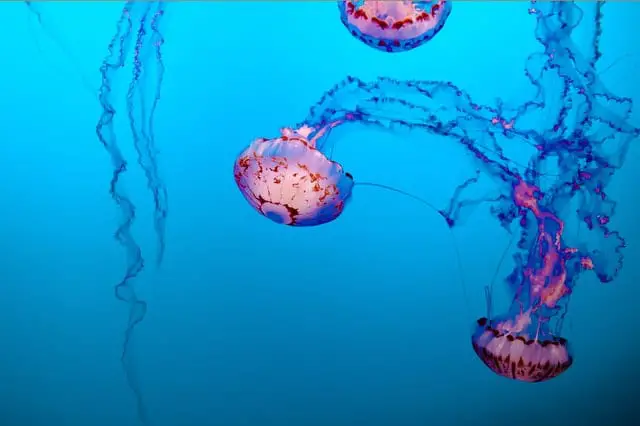 Jellyfish are scientifically known as Medusozoans. Most species of jellyfish start out as small polyps, drifting with the currents through the ocean. As they approach their “medusa stage,” they develop the unique umbrella shape that they’re most well known for.
Jellyfish are scientifically known as Medusozoans. Most species of jellyfish start out as small polyps, drifting with the currents through the ocean. As they approach their “medusa stage,” they develop the unique umbrella shape that they’re most well known for.
Although jellyfish have been around for almost 700 million years and predate the dinosaurs, they have a short lifespan. In fact, most don’t live for more than a year! They reach sexual maturity and mate during their medusa stage, leaving thousands of small polyps behind, which will eventually turn into jellyfish.
These beautifully complex creatures are still not fully understood as they are quite unlike any other living creature. In some ways, they share characteristics with sea anemones and coral species; they’re almost fish-like in other ways.
10 Unique Types Of Jellyfish
Due to coastal development, jellyfish have been more populous than ever and have made their way into intercoastal waterways around the world. As more people have had interactions with them, interest in them has grown considerably.
Currently, around 200 different species of jellyfish have been recorded and studied. While some of them are similar to one another, others look entirely different. Today, we’re going to show you 10 unique types of jellyfish. While you may have heard of some, there are bound to be a few that you never knew existed. Let’s take a look!
#1- Lion’s Mane Jellyfish
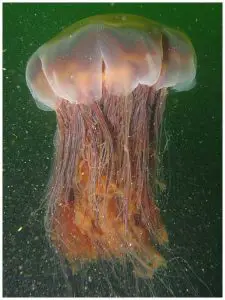
By: https://www.flickr.com/photos/hershman/
Often referred to as “The Giant Jellyfish,” these jellyfish are some of the largest jellyfish known to man. They tend to inhabit the northern hemisphere’s cold oceans, such as the North American Atlantic Ocean, the Bering Sea, and the ocean surrounding the U.K. and Scandanavia.
The largest Lion’s Mane jellyfish ever recorded had a bell diameter of 7-feet and tentacles that measured 120-feet long! That’s almost as large as a city bus. How they grow to this humungous size is still up for debate, though.
Studies show that Lion’s Mane jellyfish only live for around a year, and the fact that this creature can grow from a small polyp to the size of a bus in under 12 months is astounding.
Their name comes from their long, thick tentacles. Unlike many other species of jellyfish which have thin, long tentacles, this jellyfish species has tentacles that look almost like a male lion’s thick mane.
They’re capable of scooping up small marine life into their stinging cells and making quick work of them, metabolizing them so that they can grow even bigger. Perhaps, then, the mystery to their incredible size is simply the fact that they can
catch more prey than other jellyfish.
Encountering a giant Lion’s Mane jellyfish would certainly be frightening, but should you ever happen to get stung by one, you shouldn’t have anything to worry about. Unlike other small species of jellyfish (such as the Box Jellyfish), their sting is relatively harmless to humans. The stinging cells will still hurt a bit, but they won’t do any serious damage.
#2- Black Sea Nettle
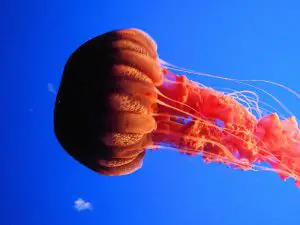
By: https://www.flickr.com/photos/jimg944/
The Black Sea Nettle is sometimes referred to as “Black Jellyfish” due to its dark profile. Although they are actually red, they are a lot darker than the more common translucent jellies that most people have come to expect.
Their brilliant red color can only be seen under bright lights (such as that of an underwater photographer). Sometimes they’re also referred to as “Sarlacc Jellies” as they bear a resemblance to the famous Sarlacc monster from the Star Wars movie franchise.
Although the Black Sea Nettle isn’t the largest jellyfish, they are a fairly large jellyfish species. Their bells have been recorded to grow up to 3-feet wide with oral arms stretching up to 20-feet long in captivity. They primarily feed by using their long tentacles to draw small fish (or other small jellies) into their mouth. Like the Lion’s Mane, their jellyfish stings are painful but relatively harmless to humans.
Although their name implies otherwise, Sea Nettles are not found in the Black Sea. Instead, they are typically found along the coast of Southern California in Monterey Bay down to Baja, Mexico. The Sea Nettle enjoys the Pacific’s cool blue waters and the rich prey that come with it.
If you ever want to observe the Sea Nettle in its natural habitat, then you can find them at the Monterey Bay Aquarium just south of San Francisco!
#3- The Box Jellyfish
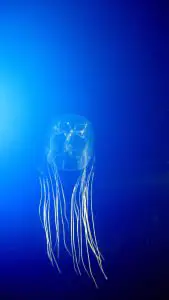
By: https://www.flickr.com/photos/of_guido/
Currently, 51 varieties of the Box Jellyfish have been recorded. Depending on which species you observe, they could be as small as your hand or as large as a full-grown person. The largest Box Jellyfish ever recorded had oral arms that were 10-feet long and a bell diameter of 1-foot (around half the size of Sea Nettles).
They are called Box Jellyfish due to their bell’s box-shaped design. Unlike other species of jellyfish, which have a circular shape, this jelly’s bell has four evenly-shaped sides. They are also the only recorded type of jellyfish to possess eyes to see. While other common jellyfish tend to drift through the sea aimlessly, these guys can move with intention, making them a dangerous predator.
In addition to their eyesight, these jellies also have a more advanced nervous system than other jellyfish species. This, in turn, means that they have the deadliest and most painful sting in the world. If you’re unlucky enough to run into their long tentacles, then the ensuing jellyfish sting can kill you within 6 minutes!
As if eyesight and deadly stinging tentacles weren’t enough to scare you away, the Box Jellyfish also happens to be the fastest type of jellyfish in the sea. Its unique box-shaped bell gives it the ability to produce a strong water jet capable of producing speeds up to 20-feet per minute.
All of this being said, you’ll want to do your best to avoid this species of jellyfish at all costs. Even if you’re able to get immediate help after being stung, there’s no guarantee that you could survive.
#4- Atolla Jellyfish
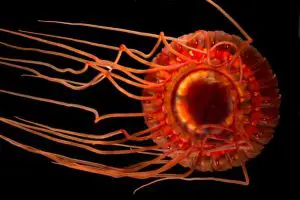
By: https://www.flickr.com/photos/27077560@N05
The Atolla Jellyfish is native to the deep sea and is found in the “Midnight Zone” around 1,000 to 4,000-meters deep. Like Sea Nettles, this jelly has a brilliant red color that is only visible under direct light. They have been found throughout the world, from the Indo Pacific region to the Atlantic.
The Atolla Jellyfish is relatively small, and its bell typically only grows to around 6-inches. This deep sea species is also bioluminescent and has earned the nickname “The Alarm Jelly.” This “alarm” function serves two purposes- to draw in prey and to avoid enemies. Whenever it feels threatened, it will rapidly flash red to attract an even bigger predator who will kill the other predator chasing it!
One interesting fact about the Atolla Jellyfish is that it lacks a brain, stomach, or digestive system. Instead, most of the important functions are controlled by one long hypertrophied tentacle which is responsible for prey/predator detection, reproduction, and even triggering its defensive bioluminescent functions.
Since they reside in the Midnight Zone, they are very rarely observed. To get that deep in the ocean requires a particular submarine, and finding jellies that deep is like a shot in the dark. As our technology improves and we’re able to learn more about the deep ocean, perhaps we’ll learn more about the Atolla and other different species of jellies that reside in the depths.
#5- Moon Jellyfish

By: Alexander Vasenin, CC BY-SA 3.0 <https://creativecommons.org/licenses/by-sa/3.0>, via Wikimedia Commons
The Moon Jelly is one of the most beautiful species of jelly in the ocean. It’s named for its resemblance to the moon. Moon Jellyfish are almost translucent and have a blue-green hue that’s caused by a green fluorescent protein produced in their bell. It typically grows about a foot in diameter and doesn’t have the long, stinging tentacles that are typical of other common jellyfish species.
There are many different types of Moon Jelly, and the only way to differentiate between them is to look at their gonads– the reproductive organs that lie at their center. Their digestive abilities are limited, so they tend to feed on small plankton instead of larger marine life like larger jellies.
Although this species is small, the Moon Jelly has a higher concentration of fatty acids in their skin. This makes them a valuable food source for larger animals like sea turtles, sunfish, and even ocean birds. They are typically found in warm waters and are common in the Indo Pacific, where the current and temperature are more consistent.
They are virtually harmless to humans as their stingers are not long enough to penetrate human skin. If you were to brush up against one, you might feel a slight stinging sensation, but it wouldn’t last for more than a couple of minutes.
#6- The Portuguese Man-of-War
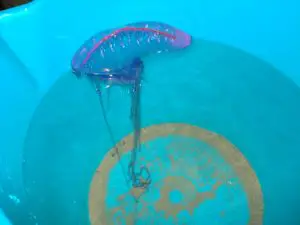
By: No machine-readable author provided. Franco.cl assumed (based on copyright claims)., Public domain, via Wikimedia Commons
The Portuguese Man-of-War is known as the “Floating Terror” for its deadly stings and long tentacles. Man-of-War bells are often called “The Blue Bottle” because they resemble smashed blue water bottles floating in the ocean.
Most people think of “Blue Bottles” as jellies, however they are a separate species. Most jellies are Medusozoans, whereas Man-of-Wars are Hydrozoans. Often confused because they look and act like jellyfish on the surface.
The Man-of-War is a “colonial organism.” Common jellies are not. It looks like one thing, yet it’s comprised of millions of microscopic zooids. Despite this major change, they share the jellyfish’s 12-month lifespan.
Man-of-Wars have modest bells compared to their body. The full-grown bell may be the size of a gallon of water. However, tentacles can reach 165 feet underwater. The usual tentacle length is 30–40 feet, which is still gigantic.
The species’ long, floating tentacles make it deadly. You’ll often be stung before you see its bell bobbing on the water. Sometimes unlucky swimmers accidentally hit detached tentacles, which are just as poisonous.
Despite being dangerous, they are gorgeous. Their vivid purple and blue bells and tentacles mix well with the warm Pacific seas they live. Hawaii is where they’re most common!
#7- Nomuras Jellyfish
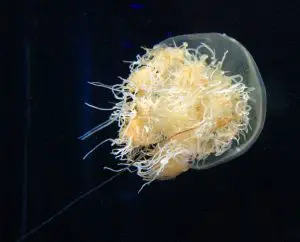
By: I, KENPEI, CC BY-SA 3.0 <http://creativecommons.org/licenses/by-sa/3.0/>, via Wikimedia Commons
Although the Lion’s Mane holds the title of the world’s largest jellyfish, the Nomuras Jellyfish is a close second. Both species of jellyfish are included in the Rhizostome order of jellies (which also includes the Spotted Jellyfish). They are known for having eight primary oral arms that branch out to form thick nets which they use to catch prey.
One of the most interesting facts about the Nomuras Jellyfish is that they can grow from the size of a grain of rice to over 6-feet wide in bell diameter in just six months!
They are native to the waters of China and Japan, where they have been known to get caught up in fishing nets. Their incredible size and weight have even led to some ships getting capsized! Nomuras Jellies can weigh up to 500-pounds at peak maturity.
Their numbers have been steadily increasing over the past couple of decades and it has become somewhat of a problem. Every year, hundreds of thousands of Chinese and Japanese swimmers and fishers are stung. Although the stings are rarely deadly, they can still cause severe allergic reactions and pain like other large types of jellyfish.
The species’ population explosion has been attributed to China’s offshore development, which has led to more debris being dropped in the ocean. The more debris that lies in the ocean, the more hard surfaces that the newborn polyps have to land and develop into full-grown jellies, which then infest the waters.
#8- The Cassiopea (“Upside-Down Jellyfish”)
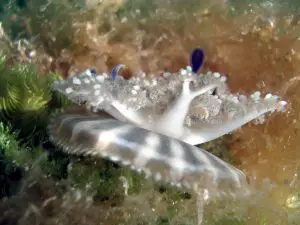
By: CiXeL at English Wikipedia, CC BY 3.0 <https://creativecommons.org/licenses/by/3.0>, via Wikimedia Commons
The Cassiopea is often referred to as an “Upside-Down Jellyfish” due to its medusa bell’s odd orientation. Unlike most common types of jellyfish with their bell at the top with tentacles trailing underneath, Cassiopea have their bells on the bottom and tentacles facing upwards.
The reason for this is that the species has developed a symbiotic relationship with dinoflagellates. These algae-like organisms live in the tentacles and need a constant source of sunlight, which is why this species positions itself upside-down. Since they need a lot of sunlight, Cassiopea jellies are typically found in the warm waters throughout the world, including Florida, the Gulf of Mexico, the Caribbean, and parts of Indonesia.
Their bells rarely grow wider than 6 to 8-inches in diameter and their tentacles range between 6-inches and 1-foot. Their sting is harmless to humans and isn’t very painful. However, it can cause itchiness and dry skin in the affected area for a day or two.
#9- The Immortal Jellyfish
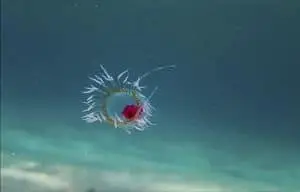
By: Bachware, CC BY-SA 4.0 <https://creativecommons.org/licenses/by-sa/4.0>, via Wikimedia Commons
Turritopsis Dohrnii is one of the most incredible types of jellyfish in the ocean. It also happens to be the only immortal living creature that exists on our planet! Most jellies only live for around a year, but the “Immortal Jellyfish” can regenerate whenever it wants.
It possesses a kind of “reset button” that it can activate whenever it’s injured. When activated, the jelly reverts to its polyp stage, literally reversing the damage. It doesn’t just do this when it’s disabled, though. can reset whenever it starts to get old or even when it gets sick. It can do this as many times as it wants and can hypothetically live forever.
Despite its amazing abilities, T. Dohrnii is an incredibly small species of jelly. Its maximum bell size is 4.5-millimeters, which is just over 1/10th of an inch. Since its discovery, scientists have noted that the species has been “silently invading” oceans around the world. Its small size is the only reason that it hasn’t been noticed until lately.
#10- Crystal Jellyfish
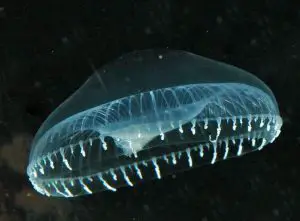
By: Sierra Blakely, Attribution, via Wikimedia Commons
Crystal Jellyfish are an incredibly beautiful variety of jellies that are found in the cooler waters of Northwestern America. They typically grow up to 10-inches in diameter and don’t have any long tentacles to speak of. In appearance, they’re quite similar to the Moon Jellyfish we discussed above.
They’ve become famous as they were the topic of an in-depth study on bioluminescence conducted by Japanese marine biologist Osamu Shimomura. His studies revealed that aequorin, a photoprotein, and green fluorescent protein are the three compounds that activate bioluminescence in sea creatures. Shimomura was given a Nobel Prize for his discovery.
Frequently Asked Questions About Jellyfish
So, now that you’ve had a chance to learn about some of the world’s most unique jellyfish, let’s take a few minutes to discuss some of the most frequently asked questions regarding these majestic and mysterious creatures.
What Is The Most Common Jellyfish?
The Aurelia Aurita, or “Moon Jellyfish” is, by far, the most common species of jellyfish. They are found in waters around the world and tend to drift with the currents. As we mentioned earlier, they are relatively harmless to humans since their stinging barbs aren’t long enough to penetrate human skin. It’s a good thing that these guys are the most common jellyfish and not the Portuguese Man of War!
How Many Types Of Jellyfish Are There?
So far, just over 2,000 different species of jellies have been discovered. They range in size from as small as a gumball to as large as a small car. However, we’ve only just begun to explore the depths of the ocean floor.
Some marine biologists estimate that there could very well be over 300,000 different species of jellyfish. We’ve only explored 5% of the ocean. The incredibly harsh environment of the deep sea makes it almost as inhospitable as space (which we actually know more about than the ocean). As our technology improves, we’ll continue to learn more and discover species that we never even knew existed!
How Long Do Jellyfish Live For?
Surprisingly, jellyfish typically only live for one year. The one exception is Turritopsis Dohrnii– the immortal jellyfish. The jelly stage is only part of the medusozoan’s life cycle. All jellies start as small polyps which drift through the ocean until they find somewhere to land.
Once they land, they can collect the food they need to grow and develop into full-grown jellies. The primary purpose of their “medusa” stage (jellyfish stage) is to reproduce and spread polyps through the ocean.
Are Some Jellyfish Harmless To Humans?
Most jellyfish contain venomous neurotoxins that are meant to paralyze and disable prey. They transmit this toxin through small barbs on their tentacles. Depending on the size of the barbs and the strength of the venom, some jellyfish stings are harmless, while others can be deadly. The best way to avoid jellyfish stings is to wear a thick wetsuit that the barbs cannot penetrate.
Can Jellyfish Sting When They’re Dead?
Yes! Although it may be tempting to poke and prod the dead jellies that wash up on the shore, it’s best to avoid it. Even though the creature may have stopped actively producing venom, the barbs are still responsive and full of it. As soon as you touch them, they can easily deposit any remaining toxins into your skin.
Can Jellyfish Live In Freshwater?
Surprisingly, yes! Although freshwater jellyfish aren’t as common as saltwater jellyfish, they do exist. There is only one species of freshwater jellyfish in America– Craspedacusta Sowerbyi. They can be found in lakes and rivers. However, they are so small that you probably wouldn’t even recognize them. They don’t pose any danger to humans and can’t sting them.
How Long Have Jellyfish Been Around For?
Jellyfish were around long before the dinosaurs. In the early-2000s, fossils were found in fine sediment deposits in Utah. The fossil was almost a perfect outline of a jellyfish, which had imprinted itself onto the stone. Carbon dating revealed that the fossil was 500 million years-old!
The fossil appeared almost exactly like our modern jellies in shape and size. This means that either Jellyfish haven’t changed since then, or that they had a quick evolution period prior to the date of the fossil. This means that jellyfish were likely around long before!
